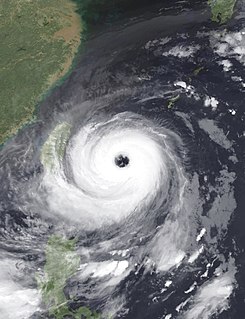The name Jose has been used for six tropical cyclones worldwide, five in the Atlantic Ocean and one in the Western Pacific Ocean, a typhoon that traversed the Philippine Atmospheric, Geophysical and Astronomical Services Administration (PAGASA) area of responsibility. The name was retired by PAGASA from future use in the region after that one use, and replaced with Josie for the 2018 Pacific typhoon season.
The name Anita has been used for thirteen tropical cyclones worldwide: one in the North Atlantic Ocean, one in the South Atlantic Ocean, two in the South-West Indian Ocean, and nine in the Western Pacific Ocean. The name Anita was retired in the North Atlantic after the 1977 hurricane season.
The name Gilda has been used for three tropical cyclones in the Atlantic Ocean, nine in the western Pacific Ocean, and one in the southwest Indian Ocean.
The name Gloria has been used for eighteen tropical cyclones worldwide: three in the Atlantic Ocean, two in the Australian region, one in the South-West Indian Ocean, and twelve in the Western Pacific Ocean. It has also been applied to one extratropical European windstorm.
The name Kalmaegi has been used to name four tropical cyclones in the northwestern Pacific Ocean. It was submitted by North Korea and is a type of seagull.
The name Holly has been used for two tropical cyclones in the Atlantic Ocean and three in the western Pacific Ocean.
The name Auring has been used for sixteen tropical cyclones in the Philippines by PAGASA in the Western Pacific Ocean.

The 2015 Pacific typhoon season was a slightly above average season that produced 27 tropical storms, 18 typhoons, and nine super typhoons. The season ran throughout 2015, though most tropical cyclones typically develop between May and November. The season's first named storm, Mekkhala, developed on January 15, while the season's last named storm, Melor, dissipated on December 17. The season saw at least one named tropical system forming in each of every month, the first time since 1965. Similar to the previous season, this season saw a high number of super typhoons. Accumulated cyclone energy (ACE) during 2015 was extremely high, the third highest since 1970, and the 2015 ACE has been attributed in part to anthropogenic warming.
The name Labuyo has been used for four tropical cyclones in the Philippines by the PAGASA in the Western Pacific Ocean. It was a given local name which derived from a kind of chili pepper plant.
The name Songda has been used for four tropical cyclones in the Western North Pacific Ocean. The name was contributed by Vietnam, and is the name of the river Sông Đà in northwestern Vietnam.
The name Onyok has been used in the Philippines by PAGASA in the Western Pacific.

Typhoon Dujuan, known in the Philippines as Typhoon Onyok, was the strongest tropical cyclone to strike the Pearl River delta since Typhoon Hope in 1979. The 13th storm and 7th typhoon of the 2003 Pacific typhoon season, Dujuan developed on August 27 to the east of Taiwan. It initially moved to the northwest, slowly intensifying into a tropical storm while drawing moisture and rainfall over the Philippines. On the island of Luzon, one person was killed and areas were flooded. Dujuan quickly intensified after turning and moving quicker to the west-northwest, developing an eye. It reached peak winds of 150 km/h (90 mph) on September 1, and shortly thereafter passed just south of Taiwan. There, Dujuan left 590,000 people without power, killed three, and caused NT$200 million in crop damage. While moving through the South China Sea, the typhoon developed concentric eyewalls. Dujuan weakened to severe tropical storm status before making landfall on September 2 in southern China, just east of Hong Kong near Shenzhen, Guangdong. The storm dissipated the next day after causing 40 deaths and ¥2.3 billion in damage. Most of the deaths were in Shenzhen where the storm moved ashore, and the city experienced a near-total power outage.

Typhoon Dujuan, known in the Philippines as Typhoon Jenny, was the second most intense tropical cyclone of the Northwest Pacific Ocean in 2015 in terms of ten-minute maximum sustained winds, tied with Noul. The twenty-first named storm and the thirteenth typhoon of the 2015 Pacific typhoon season, Dujuan brought extremely powerful winds throughout the Yaeyama Islands and Taiwan in late September, causing 3 deaths in Taiwan. The typhoon also caused over ¥2.5 billion (US$392.9 million) damage in East China.
The name Jenny has been used for five tropical cyclones world wide, once in the Atlantic Ocean, and twice in the Philippines in the Western Pacific Ocean, where it replaced the name "Juaning" after the 2011 Pacific typhoon season.

Tropical Storm Dujuan, known in the Philippines as Severe Tropical Storm Auring, was a tropical storm which caused heavy rain in the Philippines and Palau, leading to minor damage. Dujuan was the second depression and first named storm of the 2021 Pacific typhoon season. Dujuan started as a tropical depression in the Philippine Sea which slowly tracked northwestward towards the Philippines. Its strength fluctuated from February 19 to 21 due to a unfavorable environment near the storm at the time. The system was declared a tropical storm prior to its landfall in Batag Island, Laoang, Northern Samar on February 22.
The name Luding was used for ten tropical cyclones by the Philippine Atmospheric, Geophysical and Astronomical Services Administration (PAGASA) and its predecessor, the Philippine Weather Bureau, in the Western Pacific Ocean.
This page is based on this
Wikipedia article Text is available under the
CC BY-SA 4.0 license; additional terms may apply.
Images, videos and audio are available under their respective licenses.



